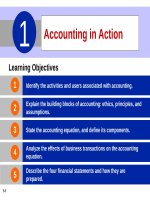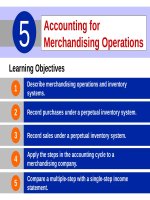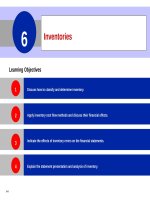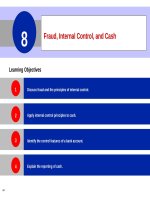Accounting principles 10e by kieso chapter 06
Bạn đang xem bản rút gọn của tài liệu. Xem và tải ngay bản đầy đủ của tài liệu tại đây (3.09 MB, 65 trang )
6-1
CHAPTER6
Inventories
6-2
PreviewofCHAPTER6
6-3
Classifying Inventory
Merchandising
Company
One Classification:
Inventory
Manufacturing
Company
Three Classifications:
Raw Materials
Work in Process
Finished Goods
Regardless of the classification, companies report all inventories under
Current Assets on the balance sheet.
6-4
6-5
Determining Inventory Quantities
Physical Inventory taken for two reasons:
Perpetual System
1. Check accuracy of inventory records.
2. Determine amount of inventory lost (wasted raw
materials, shoplifting, or employee theft).
Periodic System
1. Determine the inventory on hand.
2. Determine the cost of goods sold for the period.
6-6
SO 1 Describe the steps in determining inventory quantities.
Determining Inventory Quantities
Taking a Physical Inventory
Involves counting, weighing, or measuring each kind of
inventory on hand.
Taken,
6-7
when the business is closed or business is slow.
at end of the accounting period.
SO 1 Describe the steps in determining inventory quantities.
6-8
Determining Inventory Quantities
Determining Ownership of Goods
Goods in Transit
Purchased goods not yet received.
Sold goods not yet delivered.
Goods in transit should be included in the inventory of the
company that has legal title to the goods. Legal title is
determined by the terms of sale.
6-9
SO 1 Describe the steps in determining inventory quantities.
Determining Inventory Quantities
Goods in Transit
Illustration 6-1
Terms of sale
Ownership of the goods
passes to the buyer when the
public carrier accepts the
goods from the seller.
Ownership of the goods
remains with the seller until
the goods reach the buyer.
6-10
Determining Inventory Quantities
Question
Goods in transit should be included in the inventory of the
buyer when the:
6-11
a.
public carrier accepts the goods from the seller.
b.
goods reach the buyer.
c.
terms of sale are FOB destination.
d.
terms of sale are FOB shipping point.
SO 1 Describe the steps in determining inventory quantities.
Determining Inventory Quantities
Determining Ownership of Goods
Consigned Goods
6-12
Goods held for sale by one party.
Ownership of the goods is retained by another
party.
SO 1 Describe the steps in determining inventory quantities.
6-13
Inventory Costing
Unit costs can be applied to quantities on hand using
the following costing methods:
6-14
Specific Identification
First-in, first-out (FIFO)
Last-in, first-out (LIFO)
Average-cost
Cost Flow
Assumptions
SO 2 Explain the basis of accounting for inventories
and apply the inventory cost flow methods.
Inventory Costing
Illustration: Assume that Crivitz TV Company purchases
three identical 50-inch TVs on different dates at costs of $700,
$750, and $800. During the year Crivitz sold two sets at $1,200
each. These facts are summarized below.
Illustration 6-2
6-15
SO 2 Explain the basis of accounting for inventories
and apply the inventory cost flow methods.
Inventory Costing
Specific Identification
If Crivitz sold the TVs it purchased on February 3 and May 22,
then its cost of goods sold is $1,500 ($700 + $800), and its
ending inventory is $750.
Illustration 6-3
6-16
SO 2 Explain the basis of accounting for inventories
and apply the inventory cost flow methods.
Inventory Costing
Specific Identification
Actual physical flow costing method in which items still in
inventory are specifically costed to arrive at the total cost of
the ending inventory.
6-17
Practice is relatively rare.
Most companies make assumptions (Cost Flow
Assumptions) about which units were sold.
SO 2 Explain the basis of accounting for inventories
and apply the inventory cost flow methods.
Inventory Costing
Cost Flow
Assumptions
do not need to match the
physical movement of
goods
Illustration 6-11
Use of cost flow methods in
major U.S. companies
6-18
SO 2 Explain the basis of accounting for inventories
and apply the inventory cost flow methods.
Inventory Costing
Illustration: Data for Houston Electronics’ Astro
condensers.
Illustration 6-4
(Beginning Inventory + Purchases) - Ending Inventory = Cost of Goods Sold
6-19
SO 2 Explain the basis of accounting for inventories
and apply the inventory cost flow methods.
Inventory Costing
First-In-First-Out (FIFO)
6-20
Earliest goods purchased are first to be sold.
Often parallels actual physical flow of merchandise.
Generally good business practice to sell oldest units
first.
SO 2 Explain the basis of accounting for inventories
and apply the inventory cost flow methods.
Inventory Costing
First-In-First-Out (FIFO)
Illustration 6-5
6-21
SO 2
Inventory Costing
First-In-First-Out (FIFO)
Illustration 6-5
6-22
SO 2 Explain the basis of accounting for inventories
and apply the inventory cost flow methods.
Inventory Costing
Last-In-First-Out (FIFO)
6-23
Latest goods purchased are first to be sold.
Seldom coincides with actual physical flow of
merchandise.
Includes goods stored in piles, such as coal or hay.
SO 2 Explain the basis of accounting for inventories
and apply the inventory cost flow methods.
Inventory Costing
Last-In-First-Out (FIFO)
Illustration 6-7
6-24
SO 2
Inventory Costing
Last-In-First-Out (FIFO)
Illustration 6-7
6-25
SO 2 Explain the basis of accounting for inventories
and apply the inventory cost flow methods.









